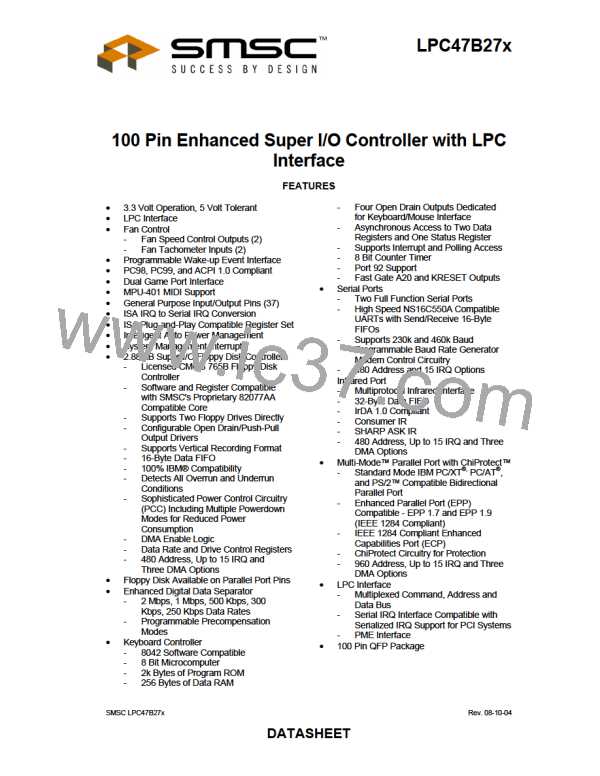Data Compression
The ECP port supports run length encoded (RLE) decompression in hardware and can transfer
compressed data to a peripheral. Run length encoded (RLE) compression in hardware is not supported.
To transfer compressed data in ECP mode, the compression count is written to the ecpAFifo and the data
byte is written to the ecpDFifo.
Compression is accomplished by counting identical bytes and transmitting an RLE byte that indicates how
many times the next byte is to be repeated. Decompression simply intercepts the RLE byte and repeats
the following byte the specified number of times. When a run-length count is received from a peripheral,
the subsequent data byte is replicated the specified number of times. A run-length count of zero specifies
that only one byte of data is represented by the next data byte, whereas a run-length count of 127
indicates that the next byte should be expanded to 128 bytes. To prevent data expansion, however,
run-length counts of zero should be avoided.
Pin Definition
The drivers for nStrobe, nAutoFd, nInit and nSelectIn are open-drain in mode 000 and are push-pull in all
other modes.
LPC Connections
The interface can never stall causing the host to hang. The width of data transfers is strictly controlled on
an I/O address basis per this specification. All FIFO-DMA transfers are byte wide, byte aligned and end on
a byte boundary. (The PWord value can be obtained by reading Configuration Register A, cnfgA,
described in the next section). Single byte wide transfers are always possible with standard or PS/2
mode using program control of the control signals.
Interrupts
The interrupts are enabled by serviceIntr in the ecr register.
serviceIntr = 1 Disables the DMA and all of the service interrupts.
serviceIntr = 0 Enables the selected interrupt condition. If the interrupting condition is valid, then the
interrupt is generated immediately when this bit is changed from a 1 to a 0. This can occur
during Programmed I/O if the number of bytes removed or added from/to the FIFO does
not cross the threshold.
An interrupt is generated when:
1. For DMA transfers: When serviceIntr is 0, dmaEn is 1 and the DMA TC cycle is received.
2. For Programmed I/O:
a.
When serviceIntr is 0, dmaEn is 0, direction is 0 and there are writeIntrThreshold or more free
bytes in the FIFO. Also, an interrupt is generated when serviceIntr is cleared to 0 whenever there
are writeIntrThreshold or more free bytes in the FIFO.
b.
When serviceIntr is 0, dmaEn is 0, direction is 1 and there are readIntrThreshold or more bytes in
the FIFO. Also, an interrupt is generated when serviceIntr is cleared to 0 whenever there are
readIntrThreshold or more bytes in the FIFO.
3. When nErrIntrEn is 0 and nFault transitions from high to low or when nErrIntrEn is set from 1 to 0 and
nFault is asserted.
4. When ackIntEn is 1 and the nAck signal transitions from a low to a high.
FIFO Operation
The FIFO threshold is set in the chip configuration registers. All data transfers to or from the parallel port
can proceed in DMA or Programmed I/O (non-DMA) mode as indicated by the selected mode. The FIFO
is used by selecting the Parallel Port FIFO mode or ECP Parallel Port Mode. (FIFO test mode will be
addressed separately.) After a reset, the FIFO is disabled. Each data byte is transferred by a
Programmed I/O cycle or DMA cycle depending on the selection of DMA or Programmed I/O mode.
The following paragraphs detail the operation of the FIFO flow control. In these descriptions, <threshold>
ranges from 1 to 16. The parameter FIFOTHR, which the user programs, is one less and ranges from 0 to
15.
A low threshold value (i.e. 2) results in longer periods of time between service requests, but requires faster
servicing of the request for both read and write cases. The host must be very responsive to the service
request. This is the desired case for use with a "fast" system. A high value of threshold (i.e. 12) is used
SMSC LPC47B27x
- 88 -
Rev. 08-10-04
DATASHEET

 SMSC [ SMSC CORPORATION ]
SMSC [ SMSC CORPORATION ]